The Five Spaces for Design in Education framework argues that design in education happens in 5 interrelated spaces: artifacts, processes, experiences, systems and culture. We have typically represented this as follows.
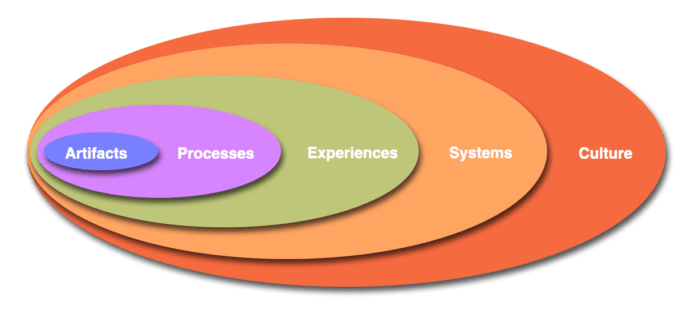
We, however, are also very aware that any representation of the world is inherently incomplete. As the Polish-American philosopher and engineer Alfred Korzybski famously said, “The map is not the territory.” So the question becomes how we do explore some alternatives to unitary representations, like the one above, to unpack the various ways these spaces interact with each other.
Below are some explorations of the 5 spaces framework.
Note: This post is adapted from a blog post written back in September 2019 for the Talking About Design website. The original can be found here. The post has been updated to reflect our current understanding of the framework (for instance, we had initially called the framework the the 5 Discourses of Design in Education). Over time, for a variety of reasons this morphed, more appropriately, into the 5 Spaces for Design in Education Framework. These sketches also reflect some other discussions about how one represents designs and ideas, some of which were explored in this paper: Designing Theory. Huge shout-out to Melissa Warr, Kevin Close, Luis Peres Cortes, Amanda Riske, Ben Scragg, Steven Weiner and other students in various iterations of the DCI691 class for inspiring some of these representations.
1. Everything connects to everything else

One cannot understand the nature of student Experience without understanding how the artifacts, processes, systems and Culture of student life are designed. To understand the typical drudgery of school requires us to understand the artifacts (such as textbooks) they engage with; the processes (such as the bell schedule) that controls their day; the systems (such as college admission requirements) that often control their goals; and the broader culture (consider the mandates of No Child Left Behind or the broader push to bring accountability to schools).
Similarly understanding the broader culture is incomplete without knowing how broader cultural imperatives are embedded within artifacts, processes, systems and culture.
The point being, any representation of the different spaces of design that privileges any one of them misses the point. In actuality, all of these five spaces define a dynamic interactive SPACE (Systems, Procedures, Artifacts, Culture and Experiences), pushing and pulling against each other. Good design is when all of these five work in synchrony.
Any representation we create that seeks to privilege any one of these discourses is wrong—because design is all of them and more.
2. Culture, one space to rule them all
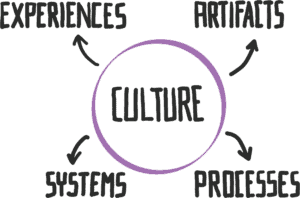
Culture is the air we breathe. Culture is the stories we tell. Culture gives our lives structure and meaning. It gives us a world-view. And hence this diagram places it at the center, indicating the importance it has in design.
Nothing makes sense without the lens of culture.
The design of twitter (or any social media platform) is as much determined by its interface, as it is by it algorithms, as much by the experience it generates in/for us; as by the broader socio-economic systems that led to its rise and the broader culture within which it functions (and in turn influences). As Alan Kay wrote:
As with most media from which things are built, whether the thing is a cathedral, a bacterium, a sonnet, a figure or a word processor, architecture dominates material. To understand clay is not ?to understand the pot. What a pot is all about can be appreciated better by understanding the creators and users of the pot and their need both to inform the material with their meaning and to abstract meaning from the form.
And the only way to understand the creators and users of the pot is through the lens of culture.
3: Systems and Processes as the backbone
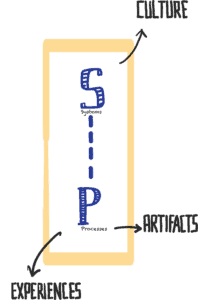
Systems and processes are, in some way, the least sexy of the spaces of design, and yet they provide the underlying skeleton on which everything hangs. Artifacts without the right processes or systems can be meaningless distractions – imagine a classroom or school with the latest tools and technologies but without coherent processes to engage students in learning. Artifacts lose meaning and experiences are hobbled.
From the point of view of culture, no positive (or negative) change can sustain unless embedded in processes and systems.
In some way this representation is close to the representation of the Juggler. Where the juggler and the uni-cycle serve the role of systems and processes that serve as the foundation and artifacts, experiences and culture are continually pushing and pulling against each other – seeking a form of dynamic equilibrium. (Thanks to Kevin Close for this idea.)

4: The interplay of tangibles and intangibles
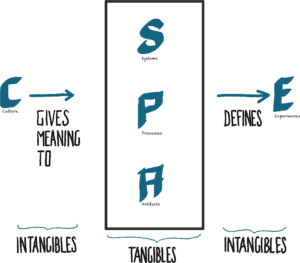
Systems, Processes and Artifacts are, at some level, tangible. Artifacts more so than Systems and Processes. Systems and processes are instantiated in policies and in ways of doing. Culture and Experience, on the other hand are harder to explain and capture.
Culture is like water is to a fish, it is the air we breathe. It gives meaning to everything we do.
Experiences are psychological in nature and thus hidden from direct perception. And yet, experience is what defines what is good and bad about a particular design and is deeply grounded in artifacts, processes and systems.
5: Playing with SPACE and words.
The first letters of Artifacts, Processes, Experiences, Systems and Culture are an acronym for the word “SPACE” – which is a happy coincidence – which can be explored further. Here are two attempts at explore the relationships of these 5 spaces? These are two different (yet somewhat similar) attempts at an answer.
The first is aspirational. Systems are meaningful when processes and artifacts align with broader culture which in turn defines our experience.
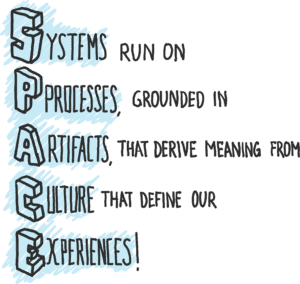
The second is more descriptive: Systems run on processes grounded in artifacts that derive meaning from culture that define our experiences.
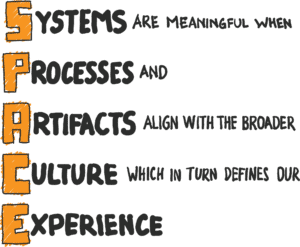
6: EPASC, anyone?
Another attempt at putting into words the 5 elements of SPACE and their relationship to each other.
Designing experiences requires aligning processes and artifacts within broader systems and culture.
For instance consider the hiring Process developed by the Office of Scholarship and Innovation. (see this page for an audio mini-case study). The goal of designing a humane and fair interview experience required us to develop new processes (identify touchpoints, send questions in advance, reach out even when a candidate was rejected and so on) and artifacts (new interview protocols that focused on projects and learning than on standard questions). None of this could have happened or made sense if not within a broader System and culture that valued innovation combined with a respect for every candidate applying for the position.


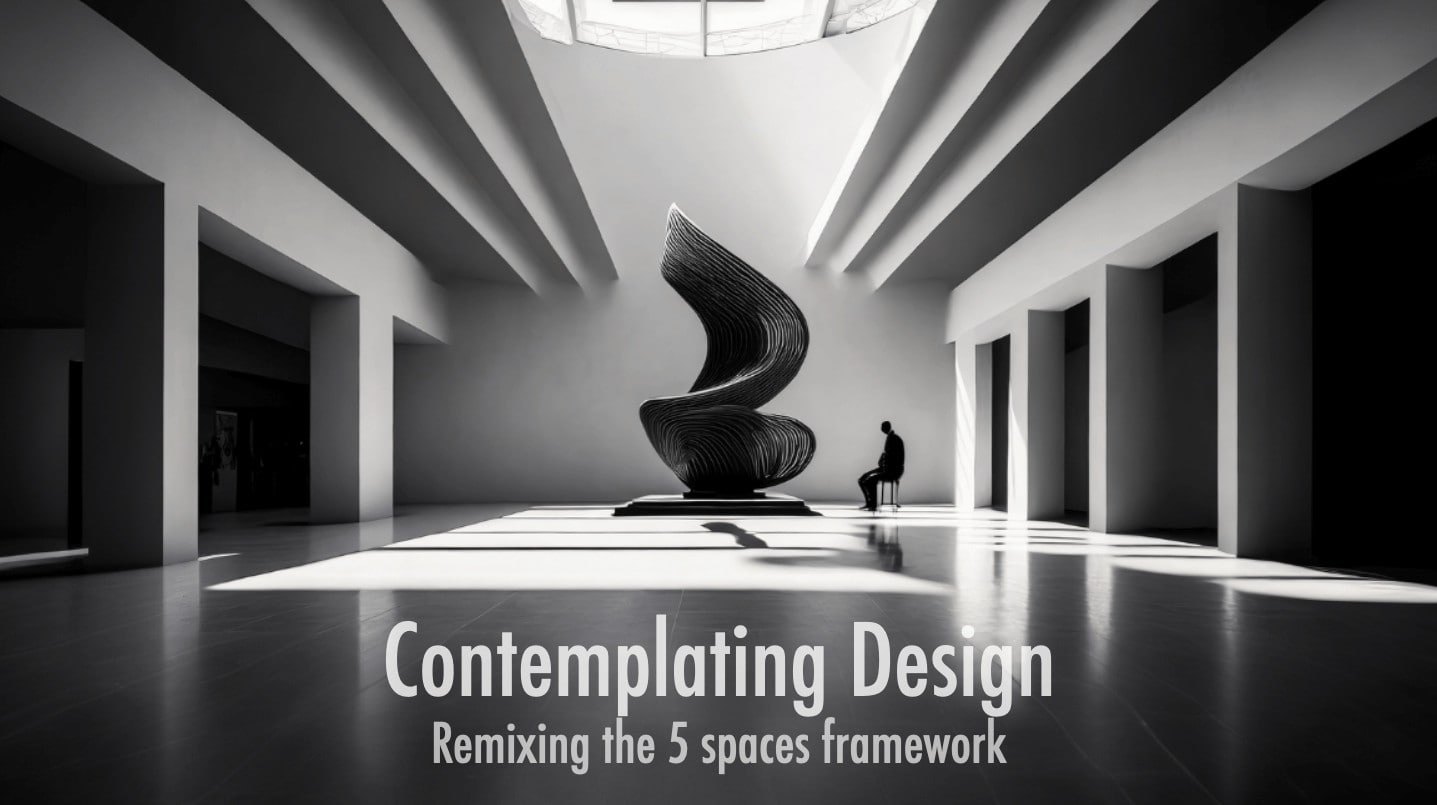

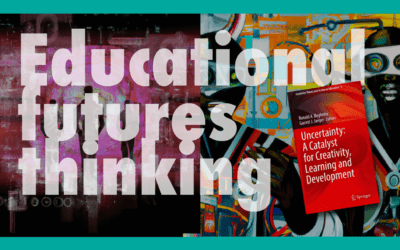
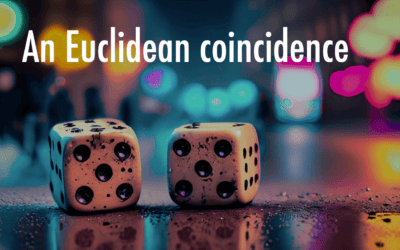

0 Comments